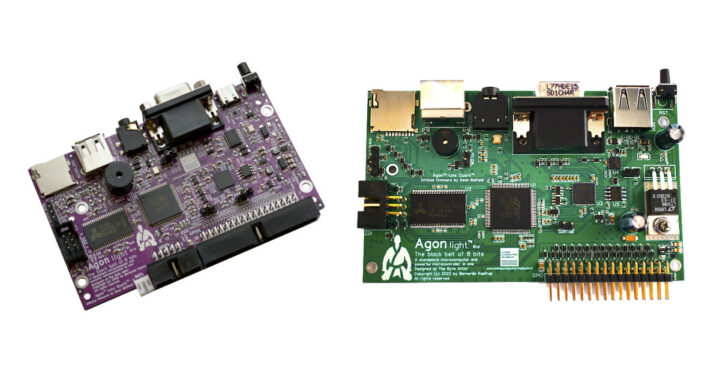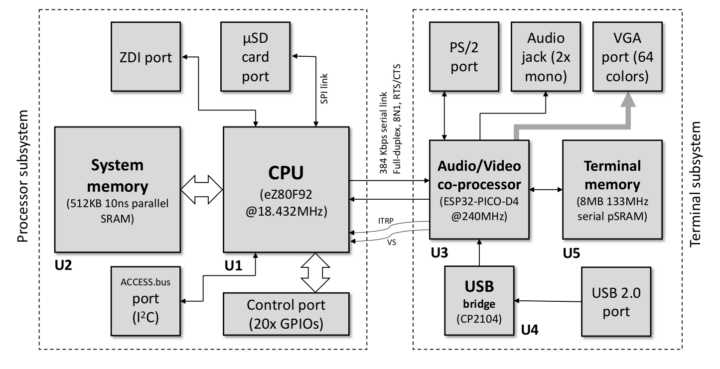Olimex has started to take pre-orders for the AgonLight2, a customized version of the Agon Light 8-bit open-source hardware computer based on the Z80 family and running BBC Basic.
Bernardo Kastrup and Dean Belfield created the Agon light 8-bit retro computer with VGA and PS2 keyboard port and programmable with BASIC earlier this year and released all hardware design files, the firmware, and documentation on GitHub, and Dean uploaded a one-hour-long video on YouTube. It was designed with EasyEDA, but Olimex re-captured the design in KiCad after getting customer requests, and the new cost-optimized board named AgonLight2 will start shipping by the end of January 2023.

AgonLight2 specifications:
- MCU – Zilog eZ80F92 8-bit microcontroller @ 18.423 MHz with 128 KB flash, 256 bytes conguration Flash memory, 8 KB SRAM (See PDF datasheet for details)
- System Memory – 512KB, 10ns, parallel SRAM
- Storage – MicroSD card socket
- Terminal subsystem
- MCU – ESP32-PICO-D4 dual-core SiP @ up to 240 MHz with 4MB flash
- Memory – 8MB, 133 MHz, serial PSRAM
- Video Output – VGA port up to 640×480 resolution, 64 colors
- Audio – 2x mono audio jacks
- USB 2.0 Type-C port for power and programming ESP32’s firmware
- USB Type-A port for keyboard
- Programming – ZDI port for programming the firmware of the CPU
- Expansions
- Plastic boxed control port with 20 GPIOs
- UEXT expansion board for Olimex add-on modules
- Power Supply
- 5V via USB Type-C port or control port; DCDC converter (up to 2A)
- LiPo battery support with charging circuit, 2-pin connector, and Vbat on control port
- Dimensions – TBD

The main changes made by Olimex are highlighted in bold in the specs above, but I’ll list them again for more clarity:
- Replaced the USB-A power connector with a USB-C connector as it is used in all new phones, tablets and devices as mandated by a new EU directive
- Replaced the PS2 connector with a USB-A connector for connecting USB keyboards without an adapter
- The Linear voltage regulator was replaced with a DCDC converted which delivers up to 2A current
- Added support for LiPo batteries
- Replaced the bare header 32-pin connector with a plastic boxed 34-pin connector, adding two additional signals Vbat and Vin which allow AgonLight to be powered by this connector too.
- Added a UEXT connector for Olimex modules
- A few other small changes and most of the components were changed to Olimex’s component base to lower costs
The new AgonLight2 supports the same Quark firmware as the Agon light with three modules: Quark BBC BASIC, Quark MOS, and Quark VDP which can be found in the GitHub repo linked in the introduction. Olimex talked with Bernardo to make sure it was a truly open-source hardware project before, and the updated board is now even featured on the official project’s page. The KiCad hardware design files and datasheets for the AgonLight2 board can be found on GitHub.
Olimex is taking pre-orders for 50 Euros for the AgonLight2, which looks like a pretty good price considering the Agon Light board had an estimated BoM cost of around $50 for a small production run. Shipping is expected to start on January 31, 2023.

Jean-Luc started CNX Software in 2010 as a part-time endeavor, before quitting his job as a software engineering manager, and starting to write daily news, and reviews full time later in 2011.
Support CNX Software! Donate via cryptocurrencies, become a Patron on Patreon, or purchase goods on Amazon or Aliexpress




